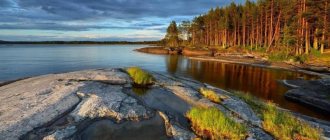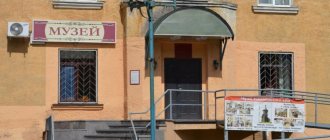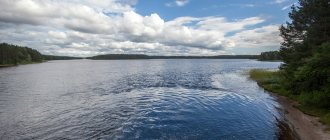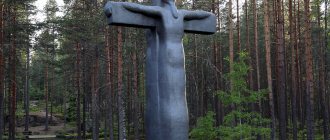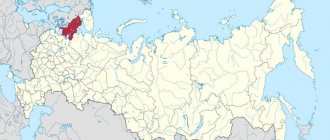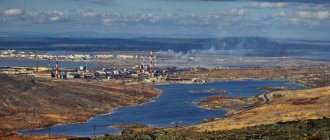Translated from Finnish, “suo” means swamp, and “järvi” means lake. The city of Suoyarvi is the administrative center of the Suoyarvi district of the Republic of Karelia. The population of Suoyarvi is 9800 people. The area lives up to its name; lakes occupy about 130 thousand hectares (9% of the territory), swamps - 341 thousand hectares (25%).
The city is located 137 km from Petrozavodsk, in the south of Karelia. It is a railway junction and the center of the woodworking industry in the Republic of Karelia. Tourism – sports and environmental – is a very promising industry. The picturesque nature of Lake Suoyarvi, the coast of which has been populated since the 14th century, attracts people here even today.
Photos of Suoyarvi (Karelia) are striking in beauty.
History of the territory since ancient times
The coast of Lake Suoyarvi attracted people's interest back in the 14th century, at which time the first settlements were formed in this area. The chronicles of 1500 mention the settlement of Kaipaa, located on the southern shore of the lake (currently an urban area), containing about 20 houses.
In 1617, the territory of the city was part of the Kingdom of Sweden.
During the reign of Peter I, during the Northern War, the entire territory of Old Finland became part of the Russian Kingdom. The Vyborg province of the province of St. Petersburg was formed.
In 1804, an iron smelter was built on the territory of the settlement.
In 1811, the Principality of Finland was formed as part of the Russian Empire and the territory of the region became part of it.
In 1917, after the October Revolution, the principality became the independent state of Finland.
From 1918 to 1940 the city of Suoyarvi (Karelia) was part of Finland.
In 1926, a timber mill and a cardboard factory were built here.
Links[edit]
Notes[edit]
- ^ abcde Law No. 871-RZK
- ^ a b Federal State Statistics Service (2011). All-Russian Population Census 2010. Volume 1 [All-Russian Population Census 2010, vol. 1]. All-Russian Population Census 2010 [All-Russian Population Census 2010] (in Russian). Federal State Statistics Service.
- "26. The size of the permanent population of the Russian Federation by municipalities as of January 1, 2022". Federal State Statistics Service. Retrieved January 23, 2022.
- ^ abcd Law No. 813-RZK
- Law No. 825-ZRK
- "On the Calculation of Time". Official Internet portal of legal information
. June 3, 2011. Retrieved January 19, 2022. - Post office. Information and computing center of OASU RPO. ( Post office
).
Search for postal service objects ( postal Search for objects
) (in Russian) - ↑
Federal State Statistics Service of Russia (May 21, 2004). The population of the Russian Federation, cities of the Russian Federation as part of federal districts, urban settlements, settlements, settlements, settlements is 3 thousand or more people. [Population of Russia, its federal districts , subjects of the Federation, districts, urban settlements, rural settlements - administrative centers and rural settlements with a population of more than 3000 people] (XLS). All-Russian Population Census of 2002 [All-Russian Population Census of 2002] (in Russian). - All-Union Population Census of 1989 Population of Union and Autonomous Republics, Autonomous Regions and Districts, Territories, Regions, Urban Settlements and Village District Centers [All-Union Population Census of 1989: Current Population of Union and Autonomous Republics, Autonomous Regions and Districts, Territories, Regions , districts, urban settlements and villages performing the functions of district administrative centers]. All-Union Population Census of 1989 [All-Union Population Census of 1989] (in Russian). Institute of Demography of the National Research University: Higher School of Economics [Institute of Demography of the National Research University: Higher School of Economics]. 1989 - via Demoscope Weekly
.
Soviet period in the history of the city
In 1939, the Russian-Finnish war began, after which, in 1940, a peace treaty was signed, part of the Vyborg province became part of the USSR. At this time, the Suoyarvi district was formed.
In 1940, the Suoyarvi-Petrozavodsk railway line began operating.
By 1941, about 8 thousand people lived in the region, about 19 collective farms were created, 24 schools and 8 libraries were opened. The Ignoil Hydroelectric Power Plant was built and launched, which is located 30 km from the city of Suoyarvi, thus solving the problem of energy supply for the region and the city.
The city of Suoyarvi was occupied by the Finnish army from the very beginning of the Great Patriotic War and was liberated by Soviet troops only in 1944.
Suoyarvi city
File:Image 011.JPG Bird's eye view of Suoyarvi
File:Image 032.JPG Lake Suoyarvi from a bird's eye view
The city of Suoyarvi is located on the shores of a picturesque lake of the same name. The name of the lake comes from the Karelian suo “swamp” and Jarvi “lake” - “swamp lake”. The city is located 139 km north of Petrozavodsk. Suoyarvi is the administrative center of the Suoyarvi district. The city's permanent resident population as of January 1, 2000 is 10.7 thousand people. The economically active population is 45% of the total number, the retirement age population is 28.6%, youth is 22.5%.
Modernity
Currently, there are about 18 schools, 17 kindergartens, 3 music schools, a children's sports school and an art school in the area. Two district hospitals admit patients. 189 enterprises operate in the city and district.
For a long time, the city-forming enterprise was considered to be the cardboard factory of the city of Suojärvi, but in 2012 the company went bankrupt. In 2013, there were massive layoffs of workers at the factory, and currently the situation has not improved; the enterprise’s debt has not been resolved either at the local or district level.
Suoyarvi in Karelia is a fairly large city and railway junction. There are two stations here.
Economics and transport
Suoyarvi is included in the list of single-industry towns in Russia; the city-forming enterprise is a cardboard factory. I work in retail and service industries, but in general, the work situation in Suojärvi is not the best.
There is a bus service with other settlements in the Suoyarvi region, as well as with neighboring regions of the Republic of Karelia. There is also a railway line Petrozavodsk-Suoyarvi. There are hotels and guest houses in the city.
Attractions
According to the design of Irina Soboleva, in 2010, the building of the Church of the Nativity of Christ was built in the city of Suoyarvi in Karelia. The temple was erected on the hill of Barskaya Gorka, which offers a picturesque view of the lake and the city.
A landmark of the city of Suoyarvi Karelia is the “Island of Love”, a small island on the lake, to which a wooden bridge leads. In Soviet times, there was a recreation park here, with playgrounds, carousels and a boat station. But at present the condition of both the bridge and the island is very deplorable.
On the territory of the city there is a mass grave where Soviet soldiers who died in battles during the war were buried. In the park on Pobeda Street there is a monument to Pyotr Tikilyainen, Hero of the USSR, who died during the liberation of the city.
The landmark and decoration of the city and the region are the railway station building at Kaipaa station and the building of the Children's Art House, built in 1930.
There are very few attractions and architectural monuments in the city itself, but tourists have a lot to see in the area.
The architectural attractions of the area are the 17th-century chapel, which is located in the village of Veshkelitsa, and the historical buildings of the villages of Pavshoila and Kaalamba.
Recently, residents of the Suoyarvi district have been calling our editorial office almost every day. People talk about the impossibility of getting to villages, unclean roads, and how they are freezing in their apartments, despite the new boiler room...
On March 23, the head of Karelia, Alexander Khudilainen, paid a working visit to Suoyarvi. We took the opportunity to find out which of the most pressing problems the townspeople paid attention to, and following a large government delegation, which included ministers and heads of departments, we went to the city, which the head himself several times publicly called the most problematic in Karelia.
Together with them, we attended a session of the city council, a meeting with the Suoyarvi business community, talked with residents of a newly built house and listened to those who do not hope to be relocated from dilapidated housing.
“Are you still at war?” Only the lazy did not write about the road to Suoyarvi. Almost every trip along it ends with suspension repairs, a torn off bumper, or other “pleasures.” The condition of the highway connecting the capital of Karelia with the regional center affects, among other things, the flow of tourists.
Last year we failed the season, partly due to the lack of roads. Groups refuse to come when they find out about our route,
– said the owner of the local guest house Tamara Shpilevaya.
Those same tourists who still risk getting to Suoyarvi then ask the local residents: “Are you still at war?”
In order to put the road in order, considerable funds are needed. But it seems that they will not be found soon.
There will be no major road repairs in Karelia this year. But about six thousand square meters of the Petrozavodsk-Suoyarvi road is planned to be repaired with so-called “maps” (that is, small sections),
– said Alexander Khudilainen.
Yes, sometimes the road is patched. And by coincidence, this happens, according to Suojärv residents, exactly before the visit of the head of Karelia.
This time, right before the visit of the government delegation, road workers were spotted at the entrance to the city. They... filled the holes in the road with gravel. Realizing the futility of such “repairs”, people helplessly throw up their hands - money is wasted. The head of Karelia was even more categorical:
If anyone dares to sign a certificate of completion of work, I will shoot him myself.
The roads in the city itself also cause a lot of complaints from citizens. In winter they are poorly cleaned, and in summer they are not removed.
Maintenance and maintenance of roads is carried out by Suoyarvskoye DRSU, a structural division of the State Unitary Enterprise of the Republic of Kazakhstan “Most”. Recently, “Most” has been in a fever, which could not but affect the activities of the DRSU: throughout 2015, Suojärvi road workers’ salaries were delayed, and in response, people went on strike. In addition, as reported by the head of the urban settlement, Roman Petrov, the DRSU lost a significant amount of work, which led to a reduction in workers.
Now the situation has not improved. The Most enterprise, as the government admitted, is on the verge of closure.
“Over the course of several years, crazy debts totaling more than 200 million rubles have accumulated, both through the fault of the company’s management and for a number of other reasons,” admitted Alexander Khudilainen. “I cannot guarantee that we will save the Bridge, but we are fighting for its fate. If we can’t save it, we will do everything to ensure that the roads do not remain abandoned.
“One house is a failure” In the distant Soviet years, the city of Suoyarvi was actively built and developed, life here was in full swing. Today Suojärvi is full of dilapidated sidewalks, old houses with peeling plaster, faded facades... There is a lot of housing that, although not officially recognized as dilapidated, looks exactly like that.
For the first time in many years, a new 18-apartment building was built here as part of the program for the resettlement of dilapidated and dilapidated housing.
The event is truly very important; many no longer believed that they would ever receive new housing. At a session of the city council, deputies noted this as an achievement. However, as the head of the republic said, one house is a failure.
The goal for 2015-2016 is 19 houses throughout the Suojärvi region. And we boast about one house,” he added. “Once upon a time, they were afraid to show the true state of things, and as a result, only 36 houses were included in the program for resettling emergency housing. Therefore, today we should not applaud one house, but stimulate construction.
According to the head of the urban settlement, Roman Petrov, as part of the program, eight houses recognized as unsafe before January 1, 2012 will be resettled in Suojärvi. The fate of another 105 old houses, which during a recent inventory “showed signs of unsuitability,” is in question – how many of them will be recognized as unsafe will be determined by a specialized organization. But they will no longer be included in the current program.
Like the wooden house on Nukhi Idrisov Street, which was once a dormitory for cardboard factory workers and was built in the very early 50s.
Now there are five families left in it, including the family of Natalya Galashina.
At first, the house was considered good when it was on the books of a cardboard factory, but then it was transferred to the municipality,” Natalya said. “The cardboard workers still looked after the house, but the city... Gradually the house fell into disrepair. So the roof is leaking. But the house was declared unsafe quite recently - in the fall of 2015, literally two days before Alexander Khudilainen arrived in Suojärvi. Although we have been writing letters for several years now.
Water, heat, tariffs What flows from the taps of comfortable houses in Suojärvi can be called drinking water with a very big stretch. Therefore, instead of a dirty yellow liquid, many people prefer water from wells. This is a long-standing problem, but no one has yet been able to solve it. In addition, Suojärv residents fear that due to the fact that the treatment facilities are not working, all wastewater goes directly into the lake. And water intake comes from it. The administration has developed the Clean Water program, but there is no money for its implementation.
Residents of the city also don’t understand why they have such large sums in their apartment payments. Some people pay 5-6 thousand rubles a month just for heat.
Prices for utility services are huge, and the quality of these services is low,” city resident Yulia Troshina shared with us. – Our house is not heated from the central boiler room, it’s cold in the apartment, and they don’t do the recalculation. The cesspool over there is overflowing, no one cares. First, some will sit in power, then others, but in the city everything will be the same.
The heat tariff in Suoyarvi is indeed higher than, for example, in Petrozavodsk.
If in the capital of Karelia the cost of one gigacalorie is 1860 thousand rubles, then in Suojärvi it is about 3 thousand rubles. To heat a 2-room apartment in cold weather, you need about two gigacalories. So this is the amount for heat,
- explained the head of Karelia, who confirmed that the problem of high tariffs exists and promised that the government will look for ways to possibly solve it.
“Dead” budget The problems of the city were discussed a lot by the participants of the city council session, the only agenda of which was a report on the activities of the head and administration of the settlement over the past year. It was recognized as satisfactory by a majority of votes of the deputy corps (13 “for”, 1 “against”, only one deputy, Vladimir Zavarkin, gave a “failed” vote). But the discussion was very heated.
The speakers talked about the sharp deterioration in bus service recently, that Suojärvi needs a good investor and new jobs, and the lack of funds in the settlement’s budget.
As Roman Petrov reported, in 2015 the budget received only 81 percent of the projected income - 33 million rubles instead of 40.5.
They say that the budget is a living organism. So here we have it, it’s dead,
- said the head of the city.
One of the reasons for poor budget filling is a decrease in incoming taxes. Including from Zapkarelles JSC - it enters into contract agreements with third-party organizations that are not registered in Suojärvi and, therefore, do not pay taxes.
“Zapkarelles” and their subtenants must be forced to pay taxes,” said Alexander Khudilainen. – This is one of the largest logging companies in the republic - the estimated logging area is about 700 thousand cubic meters. You have all the leverage.
The head of Karelia also noted the low activity of Suoyarvi small and medium-sized businesses. If in 2014 there were five active participants in receiving grants from the Ministry of Economic Development, then in 2015 there were only three.
Alexander Khudilainen spoke about the same thing during a meeting with district entrepreneurs. They discussed high loan rates for trout farms and the prospects for building an oil refinery in Suojärvi, for which it is necessary to transfer agricultural land to the category of industrial land. And this is only possible if there is a financial justification for the construction of the plant, which the company’s representatives do not yet have.
The conversation between the entrepreneurs and the head of the Republic of Kazakhstan continued for more than an hour and a half, after which both parties came to a common opinion: such meetings are useful and require continuation.
We will come here as long as necessary,
- assured the head of the region.
Step by step Successes and failures, movement forward and respite - all this is typical not only for a person, but also for any city. There are enough problems in Suoyarvi, but there are also some successes. These, of course, include the reconstruction of the hockey court, which, thanks to a program to support local initiatives, has turned into a modern sports ground. And soon a sports and recreation complex should appear in Suoyarvi, for the construction of which 71 million rubles are allocated. The sawmill, which had been idle for a long time, was launched. In the future, gas should also come to the region - gasification of Karelia continues.
Step by step, gradually, but life in the city can be changed for the better, Suoyarv residents believe. But for this it is necessary to unite the efforts of citizens, local and republican authorities.
